Electric Lit
Stacey Mason
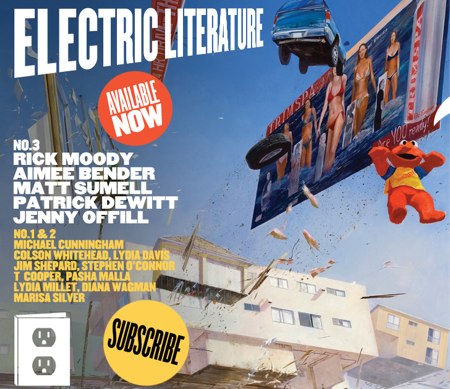
Electric Literature has just released the first literary magazine for the iPad. Cover stories by Aimee Bender, Rick Moody, and Michael Cunningham. Good submission guidelines.

Electric Literature has just released the first literary magazine for the iPad. Cover stories by Aimee Bender, Rick Moody, and Michael Cunningham. Good submission guidelines.

Comics designed on the printed page have traditionally used panels to denote space as time. Because of this key metaphor, comics have found themselves somewhat constrained in the wake of the digital revolution. On the one hand, the page boundary is no longer clear; we can have pages as big as we want. On the other hand, the screen is not print; if we want to depict motion, why not simply let things move?
Some comics have tried to take advantage of the medium by adding sound or video to panels, and it could be argued that many short flash videos have their roots in comics, but for the most part, the medium has struggled to retain the panel while taking advantage of time as it is afforded by digital media.
A simple web comic by Yves Bigerel explores this problem, and circumvents it by presenting panels sequentially through a Flash slideshow. This allows for greater authorial control over when information is presented while also allowing for certain framing tricks akin to cinematic sight gags.
Thanks, Bill Cole.
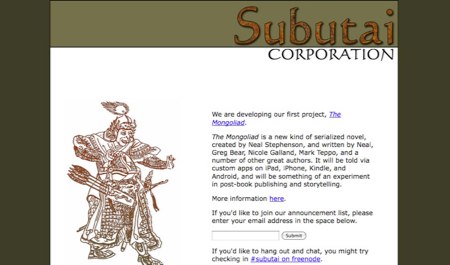
Neal Stephenson (and a few others) are releasing The Mongoliad, a serialized literary project for mobile devices. The project will also include a series of extra-narrative content for iPhone, iPad and Android clients.
Not much is known about the project to date, but it’s billing itself as “something of an experiment in post-book publishing and storytelling.” Stay tuned!
When most people think of live-action role-playing, they think of these guys:
Apparently, however, they’re not all like this. Greg Costikyan reports on Europa, a LARP that explored issues of Otherness in wartime refugee situations. A camp in Vestby, Norway became a refugee center for victims of a fictional Scandinavian conflict. Fleeing from atrocities committed by rival Scandinavian ethnics, the players were processed into a bureaucracy-ridden refugee camp staffed by oppressive “Orsinians” who spoke an incomprehensible language amongst themselves. Players remained in character for four days.
Of the session, Costikyan writes:
Reading through something like the Europa documents makes me despair of "games for change" types who want to explore issues like this and meaningfully impact peoples' attitudes with, say, Flash applications. Games can do this; games can be powerful. But not with a platformer, for God's sake. This is how it's done.
His statement is telling, and seems to reflect the argument that a certain level of player-avatar connection must be felt in order for the game to be meaningful and have a real emotional impact.
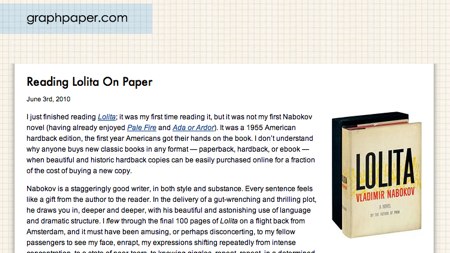
At the recent ELO conference, Terry Harpold presented a paper on the eBook as a a fetishized version of the codex, citing the ways in which we have become aware of the book’s properties as a technology and have fetishized selective traits. Yet we still can’t grasp the intangibles that we believe eBooks lack. TPage-turning animations and the loving rendition of page edges at the border of the iPad serve both to represent and to remind us of the original object.
In light of Harpold’s argument, I was struck by Christopher Fahey’s interesting anecdote on reading Lolita in print.
And what delight as, finishing the third to last, right-side-facing page, I turned to the final spread, one-and-one-half pages of text, and unexpectedly found some of the most heartbreaking words of the whole novel, right at the top of the penultimate page, the finish line within sight: an experience that was both textual and physical in its manifestation. Was it the author, the typesetter, both, or neither, who constructed — designed — this neat, sublime, perfectly-timed emotional jolt?
Even before he expressly draws his conclusion, I couldn’t help but think that some of the phenomena of reading Lolita that he describes—your eyes scanning the page for certain keywords, longing for them—would be changed on the reader I use, since the page breaks change with the adjustable font size.

Lost in a web of tangled connections? Sometimes, the best solutions are the simplest. (Original concept: David Bakker, in Dutch).
Whitney Anne Trettien has written an article for the EBR to supplement her recent digital master’s thesis on generative poetry. The article both complements the thesis and provides anecdotes on its creation:
So I began sketching ideas on graph-paper pads, receipts, discarded library catalog cards - any scrap of paper I could find. Combining these with print-outs of notes I had accumulated on my hard drive, I began cutting these bits of paper into manipulable chunks of text and image.
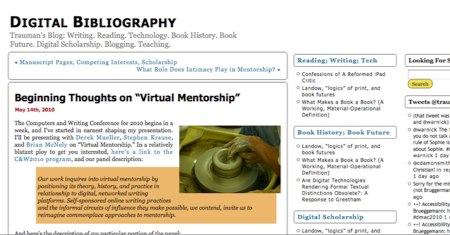
In preparation for the Computers and Writing Conference for 2010 , Ryan Trauman put together some interesting thoughts on mentorship as it relates to scholarship.
There are plenty of aspects of working productively within our discipline that have nothing to do with scholarship. How do you know when it’s time to take a break? What do you do when you’re at the end of your rope? What are the dangers of dating someone within the discipline? Are there any shortcuts on the way to tenure? … And these sorts of questions are really just the general questions. Anyone might be interested in these conversations, and they really are most productively engaged with a mentor who is honest and trusts whoever might be listening.
Trauman also examines the role of intimacy in mentorship and concludes that perhaps it's a combination of obscurity and privacy—even when the conversations are not particularly secret—that are important to fostering a mentorship.

photo: Calum Tsang. Taken at the dinner cruise.
Eastgate returned from Hypertext 2010 in Toronto, exhausted but also encouraged by the interest in narratives in generative and locative systems.
Excellent talks included Charlie Hargood’s presentation of semiotic systems for generative narrative photo montages, Heiko Haller’s iMapping presentation, and James Goulding’s talk on transclusion and hypertext structures.
But the real standout session was an impromptu breakout session organized by Nate Matias on Monday afternoon to discuss narrative hypertexts and interesting games. Topics ranged from narrativist games like Sweet Agatha and Shadow Unit to using fictional Twitter accounts as a means to extend serial narratives that live on the Web and off. Sometimes using Twitter is just a marketing ploy, but what determines if this practice is working? The quality of the tweets? Is there credit to fictional characters offering completely mundane tweets? Is there really a difference in the fictional account used for marketing and the one used for content delivery?
We also discussed Jason Rohrer’s new Sleep is Death, an interesting two-player game that exists somewhere between the table-top RPG and improvisational narrative. One player acts as a game master to create a world and control NPCs while the other player interacts with the world. However, a 30 second time limit per turn prevents the type of planning that normally goes into a tabletop RPG, making the narrative more fluid and dynamic. The result is a game with considerable gameplay constraint that in many ways frees the narrative from the constraints of the gamemaster’s railroading. It’s also interesting that the low-tech graphics play a huge role in allowing enough ambiguity to call a small person either a baby, a child, a dwarf, a gnome, and so forth. This kind of inventive gameplay would not be possible with the dazzling graphics of current-generation systems.
The group also discussed the adaptation of print fiction to hypertext forms, focusing much attention on Sherlock Holmes adaptations and pastiches. Sherlock Holmes as a Hyperbook and a stretchtext were mentioned, as well as an adaptation of a half-finished story that was adapted as an interactive narrative . Here we see another example of constraining narrative operation allowing for freer story elements.
Though I do regret that certain panels were scheduled opposite each other, it was a good conference overall with wonderfully fascinating people. I can’t wait for next year in Eindhoven.
For much of history, writing has been considered a solitary act. I would be lying if I didn’t have the occasional fantasy about being a romantic caricature, writing in some ivy-strangled brick workshop that I would call my fortress of solitude whenever friends came to visit.
Jed Perl questions the way we’ve come to view writing in the era of blogging and tweeting. Has the reading public begun to feel entitled to all of a writer’s writing whether it was intended to be published or not?
The strange thing about Other Flowers: Uncollected Poems—which contains 163 poems discovered among Schuyler’s papers in the Mandeville Special Collections Library at the University of California, San Diego—is that the editors, James Meetze and Simon Pettet, feel no obligation to explain why this book exists. Didn’t anybody wonder why these poems were not published during Schuyler’s lifetime? There are many possible explanations. Schuyler might have thought certain poems were not good enough. Or he might have thought there was some virtue in publishing less rather than more. Or it may be that an editor prevented him from publishing things he in fact wanted to publish. But none of these questions is even considered, at least not in the brief introductory texts that the editors have included with Other Flowers. The idea—extremely simple, even simplistic—appears to be that if it was written it needs to be read.
The magic of writing is the intimate one-on-one connection between writer and reader. Are we losing that intimacy and depth when the writer knows that this work will be read by millions as soon as she presses enter? Perl argues that writers must “to some degree believe they are alone with their own words.” Otherwise, if writers are always aware of their audience, can they really let their guard down and write with the raw emotion that can be beautiful and ugly, but is always inevitably true?
I’m not arguing that there are no emotional weblogs, but the majority of them are written on emotionally safe subjects or are written in a guarded manner. But if a blogger can actually write with their guard down, you probably have an exceptionally good weblog on your hands.
David Jhave Johnston posted a video from ELO AI. 51 Responses: “What inspired you to get involved in digital literature?”
If you’re short on time, there’s also a condensed video called 51 Keywords .
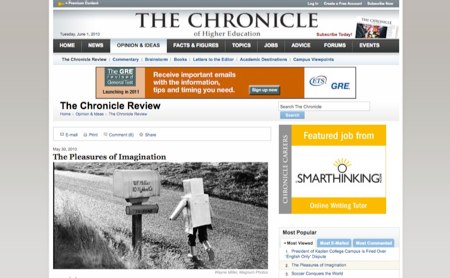
Why is it that we’re willing to spend hours reading; playing games; and watching television, movies, and plays? According to Paul Bloom, it’s because most of us spend the majority of our leisure time caught up in the imaginary, a fact which might arise from our lack of total separation of the real and the imaginary.
We enjoy imaginative experiences because at some level we don't distinguish them from real ones. This is a powerful idea, one that I think is basically—though not entirely—right. (Certain phenomena, including horror movies and masochistic daydreams, require a different type of explanation.)
The capacity for imaginative pleasure is universal, and it emerges early in development. […] In some cultures, play is encouraged; in others, children have to sneak off to do it. But it is always there. Failure to play and pretend is a sign of a neurological problem, one of the early symptoms of autism.
Bloom argues that fiction can act as augmented reality, “just as artificial sweeteners can be sweeter than suger,” though he qualifies this statement with the fact that we care just as much about the fascinating events of fiction when they happen in the real world, citing that millions of people tuned in to watch the O.J. Simpson trial.
Bloom doesn’t touch on the fact that engaging “real life” events l— the O.J. Simpson trial, the bombing of Pearl Harbor — are experienced at one remove. The mediation of a television or other devices offers us both real and imaginary stories. It’s not unreasonable to suspect that just as there is some part of us that experiences the imaginary as real, there may be some part of us that experiences remediated reality as imaginary.
Here at Eastgate, we’ve recently been talking a lot about locative stories and thinking about the possibilities that they might entail.
Locative hypertexts are intended to be read in a specific place. Often, these have been tourist destinations: a museum, or a historic building, or a monument. Many other sites can be imagined.
One question that was brought up today was a good one: how far is too far to make someone go for a story? A mile? Two? A continent?
Does it need to be someplace accessible by foot? Artificial Reality Games often ask players to travel to places by car, is this something a reader would be willing to do as well?
Interesting questions to think about as we start diving into a new form of storytelling.
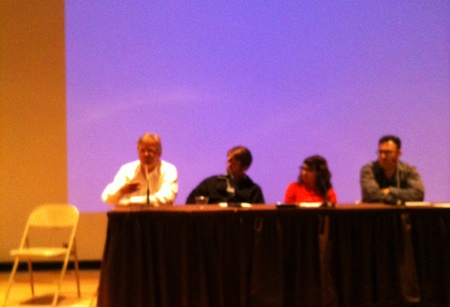
ELO’s Archive and Innovate conference last weekend was filled with excitement, criticism, and of course, scholarship.
The weekend began with digital art exhibitions, workshops, and an undergraduate session which was reportedly very successful. Friday saw outstanding talks from Eastgate’s Mark Bernstein on Stretchtext; Terry Harpold, who gave a wonderful look at the eBook as a fetishization of the physicality of the book; and an amazing demonstration of Snapdragon AR by Caitlin Fisher, which created breathtaking digital pop-up works . Other talks included Rita Raley on the political in eLit and Scott Rettberg with an anecdotal look at the founding of ELO and impact of Robert Coover.
On Saturday, Astrid Ensslin did a great close reading of Deena Larsen’s The Princess Murderer with focus on the word “you” as a diagetic/extradiagetic signifier. Nick Montfort demonstrated Curveship , his dynamic narrative platform, with previews of a couple of upcoming works: Adventures in Style, an interesting cross between Queneau’s Exercices de style, and Will Crowther’s Adventure . Fox Harrell gave an impressive demonstration of his Living Liberia Batik. And after a day of good talks, we had a huge banquet to honor Robert Coover and to announce new ELO board members and officers (congratulations to all!).
As the conference wound down on Sunday, issues of archiving arose, underlining the fragility of the medium and questioning the role of an archivist; whose job is it to preserve these digital works? Questions of the ELO’s commitment to self-reflection and betterment arose at the very end, but after a weekend of heated debate and excited discussion and reminiscence, many were ready to go and attentions fizzled on what could have been a productive discussion.
Overall, though, the conference was very active , and I did think the mixture of artistic productions and scholarly papers worked nicely. Huge thanks to John Cayley and his students for their hard work.

Eric Fischer’s visualization of Bay Area traffic.
Gene Golovchinsky reminds us that while visualizations are useful ways of presenting data, they are not all necessarily insightful. He examines two types of visualization: exploratory and recommendation: Swinehart Choose-Your-Own-Adventure visualization is exploratory while a map of high-traffic tourist areas in San Francisco is recommendation .
Golovchinsky advises us to understand how each type affects our insight:
The upshot is that visualizations can support both entertainment and exploration, and that the two aren’t always separable. But we should be clear about the intent of the visualization and try to design visualizations with enough depth to be useful not just as pretty pictures, but also as vehicles for generating the appropriate type of insight.
In his recent article, Ebert asked why gamers are so concerned with declaring games to be “art.” The answer to this is easy: games no longer want to be considered trivial.
For centuries, we have used games as a means of play. We use them to escape from work, to have fun. But something about “play” and “fun” implies that they can’t also be serious and raise serious questions about the human condition.
Video games started as a distraction, but the medium has grown into something else . These days, the level of involvement ranges from casual to hardcore, and games range from fun to work. If you don’t believe me, see any discussion on World of Warcraft as an economic machine, both through the in-game economy —and it’s application to the real-world economy —and in the players’ approach to ‘play’. Video games are starting to look like something more than jan unproductive distraction.
Games haven’t fully grown up, and like an independent teen, their insistence that they should be taken seriously just shows how much farther they have to go. However, many game producers are seeing this enormous potential and are starting to really understand what the medium can do. These games want to evoke real and complicated emotion, tell deeply human stories, and connect with the player in ways that other media can’t.
Sounds like art to me.